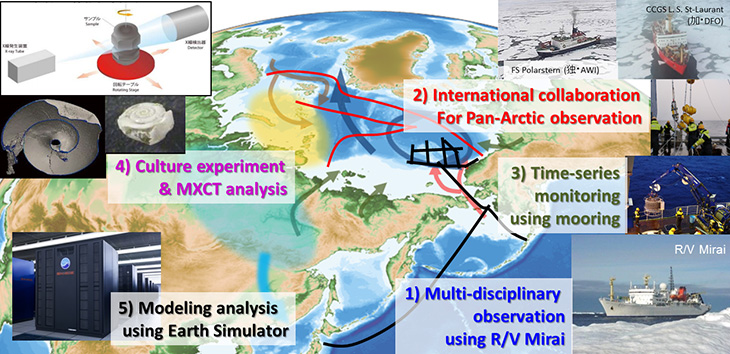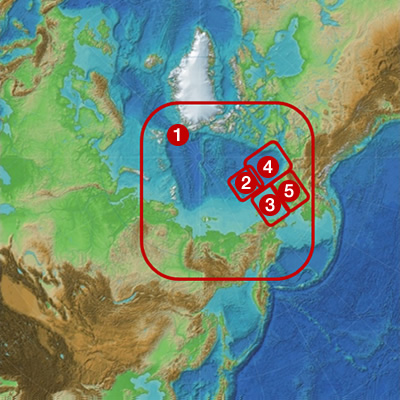Theme 4
Observational research on Arctic Ocean environmental changes

PI : Takashi Kikuchi (JAMSTEC)
Study Sites : Pan-Arctic area, Chukchi Borderland, Chukchi Sea, Canada Basin, Coastal area off Barrow, Alaska
Background of the Research
Changes in the Arctic Ocean environment, typically shown as unpredictably rapid reductions of sea ice in the Arctic Ocean, are well known as one of the most remarkable evidence of global warming. Such sea ice reduction is closely related to significant warming, freshening and ocean acidification in the Arctic Ocean, and these changes are matters of concern for marine ecosystems and biogeochemical cycles. Furthermore, changes in air-sea interaction due to sea ice reduction in the Arctic certainly have climatological impacts not only in the Arctic region, but also for the global climate system. Changes in the Arctic environment and these impacts on marine ecosystems and the climate are among the most important issues for the Arctic countries as well as non-Arctic countries, including Japan. Amid the growing concern about global climate change and interest in Arctic environmental issues, Japan was admitted as an Observer at the Arctic Council in May 2013, and presented Japan’s Arctic Policy in October 2015. Further international contributions to Arctic environmental and climate issues from scientific points of view are very important, as noted in Japan’s Arctic Policy.
Overview of the Research
The overall theme of our research is to elucidate the status and trends of ongoing Arctic Ocean environmental changes and to evaluate their impact on Arctic marine ecosystems (mainly focused on lower trophic levels) and the global climate system (e.g., climatological and hydrological interaction between the Arctic and sub-Arctic regions). Specific themes of our research are: (1) to understand ongoing changes in physical and biogeochemical conditions in the Arctic Ocean and seasonal/inter-annual variability in interactions between climatological and hydrological systems and changes in the Arctic environment; (2) to evaluate the effect of ocean warming and acidification on marine ecosystems in the Arctic Ocean; (3) to understand seasonal/inter-annual variability in the freshwater budget in the Arctic Ocean; and (4) to understand variability in sea ice dynamics, especially for the Alaskan coast.
To achieve these scientific purposes, we plan to carry out: (1) field observation, mainly in the Pacific sector of the Arctic Ocean, by using R/V Mirai and icebreakers under international collaboration; (2) year-long mooring observations at key areas of ongoing Arctic changes; (3) on-site and laboratory experiments to evaluate impacts of changes in the Arctic environment; and (4) numerical modeling to address details of changes in the Arctic environment. International collaboration is indispensable for our research activities. Based on our previous experience, we are continuing our collaboration with the US, Canada, Norway, Germany, Russia and other countries.

Schematic of Observational research on Arctic Ocean environmental changes
Cooperative Institutions / International Projects
Department of Fisheries and Ocean (Canada), National Oceanic and Atmospheric Administration (US), University of Alaska, Fairbanks (US), Norwegian Polar Institute (Norway), Institute of Marine Research (Norway), Alfred Wegener Institute (Germany), Russia Academy of Science (Russia), Korea Polar Research Institute (Korea) *under planning, etc.
Pacific Arctic Group (PAG), Distributed Biological Observatory (DBO), International Arctic Systems for Observing the Atmosphere (IASOA), CliC sea ice group, International Permafrost Association (IPA), International Arctic Buoy Programme (IABP), Forum for Arctic Modeling & Observational Synthesis (FAMOS), Synoptic Arctic Survey (SAS), Ecosystem Studies of Sub-Arctic and Arctic Seas (ESSAS), RACArctic, etc.
Implementation Structure
Members
| Name | Institutes |
|---|---|
| Takashi Kikuchi | JAMSTEC |
| Motoyo Itoh | JAMSTEC |
| Satoshi Kimura | JAMSTEC |
| Shigeto Nishino | JAMSTEC |
| Park, Hotaek | JAMSTEC |
| Amane Fujiwara | JAMSTEC |
| Akihiko Murata | JAMSTEC |
| Sayaka Yasunaka | JAMSTEC |
| Eiji Watanabe | JAMSTEC |
| Sohiko Kameyama | Hokkaido University |
| Naomi Harada | JAMSTEC |
| Jonaotaro Onodera | JAMSTEC |
| Minoru Kitamura | JAMSTEC |
| Name | Institutes |
|---|---|
| Hajime Kimura | JAMSTEC |
| Katsunori Kimoto | JAMSTEC |
| Koji Sugie | JAMSTEC |
| Maki Noguchi | JAMSTEC |
| Takuhei Shiozaki | JAMSTEC |
| Michiyo Kawai | Tokyo University of Marine Science and Technology |
| Kohei Mizobata | Tokyo University of Marine Science and Technology |
| Yasushi Fukamachi | Hokkaido University |
| Keiichiro Ohshima | Hokkaido University |
| Daisuke Hirano | Hokkaido University |
| Toru Takatsuka | Hokkaido University |
Collaborators
| Name | Institutes |
|---|---|
| Yoshihiro Iijima | Mie University |
| Masato Ito | Hokkaido University |
| Yusuke Kawaguchi | The University of Tokyo |
| Kazuhiro Oshima | Institute for Environmental Sciences |
| Akio Ishida | Tokoha University |
| Takahito Ikenoue | Marine Ecology Research Institute (MERI) |
| Name | Institutes |
|---|---|
| Masao Ishii | Meteorological Research Institute |
| Naohiro Kosugi | Meteorological Research Institute |
| Daisuke Sasano | Meteorological Research Institute |
| Katsuya Toyama | Meteorological Research Institute |
| Yasunori Tohjima | National Institute for Environmental Studies |
| Shigeyuki Ishidoya | National Institute of Advanced Industrial Science and Technology (AIST) |
| Masatake Hori | National Institute of Polar Research |
Study Sites (Map)
- ❶Pan-Arctic area
- ❷Chukchi Borderland
- ❸Chukchi Sea
- ❹Canada Basin
- ❺Coastal area off Barrow, Alaska

ArCS Blog
- Arctic ocean cruise of CCGS Louis S. St-Laurent in 2018 (November 14, 2018)
- Arctic Ocean cruise of I/B Araon in 2018 (September 20, 2018)
- Report of field trip to CHARS, Cambridge Bay (August 13, 2018)
- Report on the Scientist Quest “What will happen in the Arctic? Ocean, Life and People” in Miraikan (March 16, 2018)
- Mooring observations off the coast of Utqiaġvik, Alaska (January 09, 2018)
- R/V Mirai Arctic Ocean Cruise in 2016 (November 09, 2016)
- Impact of multiple environmental factors on phytoplankton community in the Arctic (MIRAI Arctic cruise 2016: Theme 4) (November 04, 2016)




